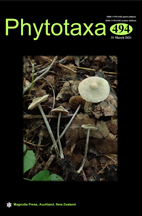Abstract
Here we describe a natural hybrid of Philippine Begonia from Bulabog Puti-an National Park in Dingle, Iloilo, Panay Island. The hybrid, named Begonia ×dinglensis after its place of origin, grows on moist, coralline-rock slopes at 200 m elevation. Morphological, molecular, and cytological evidence support its origin from natural hybridization between Philippine endemics B. camiguinensis and B. nigritarum.

